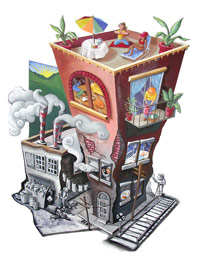The wrong side of the tracks: we often talk about a figurative gulf between rich and poor in the United States, but as this phrase suggests, there is also a literal chasm between the classes.
If you live in poverty in this country, odds are you live in the “bad” parts of town — the parts that are dirtier, more dangerous, harder to access, underserved by schools and stores and social services, and short on the aesthetic charms and everyday conveniences that the wealthy take for granted. That, in turn, affects virtually everything about how you interact with the environment, from the air you breathe to the food you buy, from the length of your commute to the length of your life expectancy.
In “A House Divided,” visual artist Keri Rosebraugh offers a creative interpretation of this class divide and its consequences.
Click here for the full-size, interactive illustration.
Read more from our Poverty & the Environment series.


